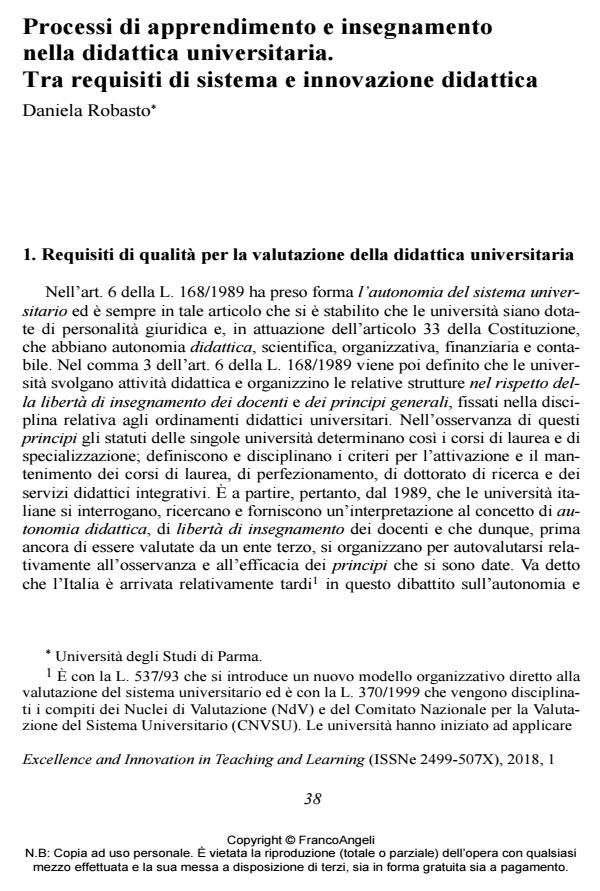Learning and teaching processes in university teaching. Between system requirements and didactic innovation
Journal title EXCELLENCE AND INNOVATION IN LEARNING AND TEACHING
Author/s Daniela Robasto
Publishing Year 2018 Issue 2018/1
Language Italian Pages 21 P. 38-58 File size 1500 KB
DOI 10.3280/EXI2018-001003
DOI is like a bar code for intellectual property: to have more infomation
click here
Below, you can see the article first page
If you want to buy this article in PDF format, you can do it, following the instructions to buy download credits

FrancoAngeli is member of Publishers International Linking Association, Inc (PILA), a not-for-profit association which run the CrossRef service enabling links to and from online scholarly content.
The national and international pedagogical literature regarding the evaluation and self-evaluation processes of higher education systems, highlighted the possible distortions, in terms of effectiveness of the teaching-learning process, of the use of tools for assessment based on the opinion of students (Feldman, 1986; Rahnema, Kroll, & Jennings, 2007) or on product or result indicators (Jones & Taylor, 1990). Frequently the risk is not to detect what is the teaching provided and what are the expected learning outcomes (and then those achieved). If we take into consideration the R3 indicators adopted by ANVUR in the Italian AVA system, there is a partial confirmation of the roots that are not strictly pedagogical from which the first methodological choices of evaluation and self-evaluation of the university system have taken place, but new openings and new spaces can also be seen, for a joint and interdisciplinary reflection, aimed at improving the teaching/learning processes. In the present paper, after a brief legislative framework concerning the concept of autonomy (including teaching) of the university system, the syllabus is presented as the main documentary source for self-assessment of the subjective and collegial interpretation of the concept of didactic autonomy. In the final part of the paper there is also a pilot project that was launched in the University of Parma and which has continued, at the same time, targeted interventions for teacher training, diagnostic surveys and innovation in teaching processes.
Keywords: University teaching, learning processes, system self-assessment, didactic innovation, syllabus.
- Costruire comunità di ricerca dialogiche: quando l'aula accademica diventa uno spazio di formazione e possibilità interculturali Isabella Pescarmona, Valerio Ferrero, in EXCELLENCE AND INNOVATION IN LEARNING AND TEACHING 1/2024 pp.40
DOI: 10.3280/exioa1-2024oa18032 - Come costruire un Syllabus Learner-centred? Creazione e Validazione di una Rubrica di (Auto)valutazione del Syllabus Anna Serbati, Sabrina Maniero, Marcella Bracale, Silvia Caretta, in EXCELLENCE AND INNOVATION IN LEARNING AND TEACHING 1/2021 pp.97
DOI: 10.3280/exioa1-2021oa12067
Daniela Robasto, Processi di apprendimento e insegnamento nella didattica universitaria. Tra requisiti di sistema e innovazione didattica in "EXCELLENCE AND INNOVATION IN LEARNING AND TEACHING" 1/2018, pp 38-58, DOI: 10.3280/EXI2018-001003